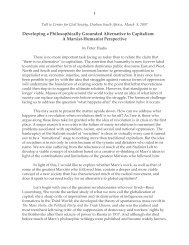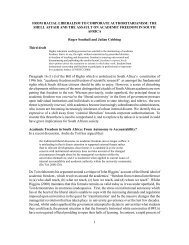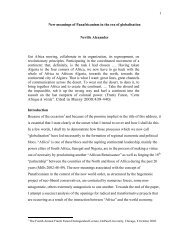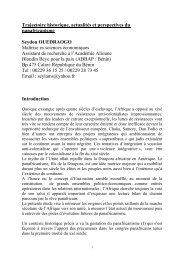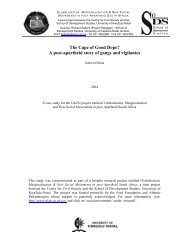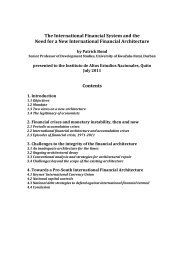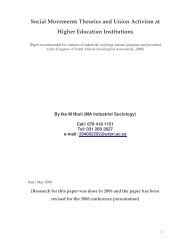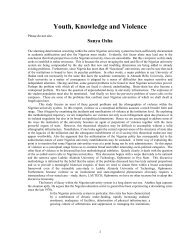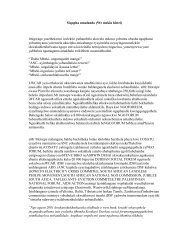April 2011 - Centre for Civil Society - University of KwaZulu-Natal
April 2011 - Centre for Civil Society - University of KwaZulu-Natal
April 2011 - Centre for Civil Society - University of KwaZulu-Natal
You also want an ePaper? Increase the reach of your titles
YUMPU automatically turns print PDFs into web optimized ePapers that Google loves.
catastrophically and which require a third more coal to run, or the nuclear<br />
energy revival notwithstanding more shutdowns at the main plant, Koeberg<br />
(five years ago the industry minister, Alec Erwin, notoriously described as<br />
‘sabotage’ a minor Koeberg accident that cost the ruling party its control<br />
<strong>of</strong> Cape Town in the subsequent municipal election); and<br />
• South African ‘global climate leadership’ will be touted, even though<br />
Pretoria’s reactionary United Nations negotiating stance includes fronting<br />
<strong>for</strong> Washington’s much-condemned 2009 Copenhagen Accord, which even if<br />
implemented faithfully, by all accounts, will roast Africa with a projected<br />
temperature rise <strong>of</strong> 3.5°C.<br />
As even the government’s new National Climate Change Response Green<br />
Paper admits, “Should multi-lateral international action not effectively<br />
limit the average global temperature increase to below at least 2°C above<br />
pre-industrial levels, the potential impacts on South Africa in the medium-<br />
to long-term are significant and potentially catastrophic.” The paper warns<br />
that under conservative assumptions, “after 2050, warming is projected to<br />
reach around 3-4°C along the coast, and 6-7°C in the interior” – which is,<br />
simply, non-survivable.<br />
If President Jacob Zuma’s government really cared about climate and<br />
about his relatives in rural <strong>KwaZulu</strong>-<strong>Natal</strong> villages who are amongst those<br />
most adversely affected by worsening droughts and floods, then it would<br />
not only halt the $21 billion worth <strong>of</strong> electricity generators being built by<br />
state power company Eskom: Medupi is under construction and Kusile will<br />
begin soon. Pretoria would also deny approval to the <strong>for</strong>ty new mines<br />
allegedly needed to supply the plants with coal, <strong>for</strong> just as at the Cradle <strong>of</strong><br />
Humankind and in West Virginia, these mines will cause permanent<br />
contamination <strong>of</strong> rivers and water tables, increased mercury residues and<br />
global warming.<br />
More evidence <strong>of</strong> the Witwatersrand’s degradation comes from tireless<br />
water campaigner Mariette Liefferink, who counts 270 tailings dams in a<br />
400 square kilometer mining zone. With gold nearly depleted, as Liefferink<br />
told a Joburg paper last week, uranium is an eco-social activist target:<br />
“Nowhere in the world do you see these mountains <strong>of</strong> uranium and people<br />
living in and among them. You have people living on hazardous toxic waste<br />
and <strong>of</strong> course some areas are also high in radioactivity.”<br />
The toxic tailings dams are typically unlined, unvegetated and unable to<br />
contain the mines’ prolific air, water and soil pollution. Other long-term<br />
anti-mining struggles continue in South African locales: against platinum in<br />
the Northwest and Limpopo provinces, against titanium on the Eastern<br />
Cape’s Wild Coast, and against coal in the area bordering Zimbabwe known<br />
as Mapungubwe where relics from a priceless ancient civilization will be<br />
destroyed unless mining is halted (as even the government agrees).<br />
There’s another reason that the power <strong>of</strong> what is termed the Minerals-<br />
Energy Complex continues unchecked, even as treasures like the Cradle –<br />
and also the priceless Kruger Park’s surface water plus millions <strong>of</strong> people’s<br />
health – are threatened: political bribery. In addition to supplying the<br />
world’s cheapest power to BHP Billiton and Anglo American Corporation<br />
smelters by honoring dubious apartheid-era deals, Eskom’s coal-fired<br />
mega-plants will provide millions <strong>of</strong> dollars to African National Congress<br />
(ANC) party c<strong>of</strong>fers through crony-capitalist relations with the Japanese<br />
firm Hitachi.<br />
Last year, Pretoria’s own ombudsman termed the role <strong>of</strong> then Eskom<br />
chairman and ANC Finance Committee member Valli Moosa ‘improper’ in



